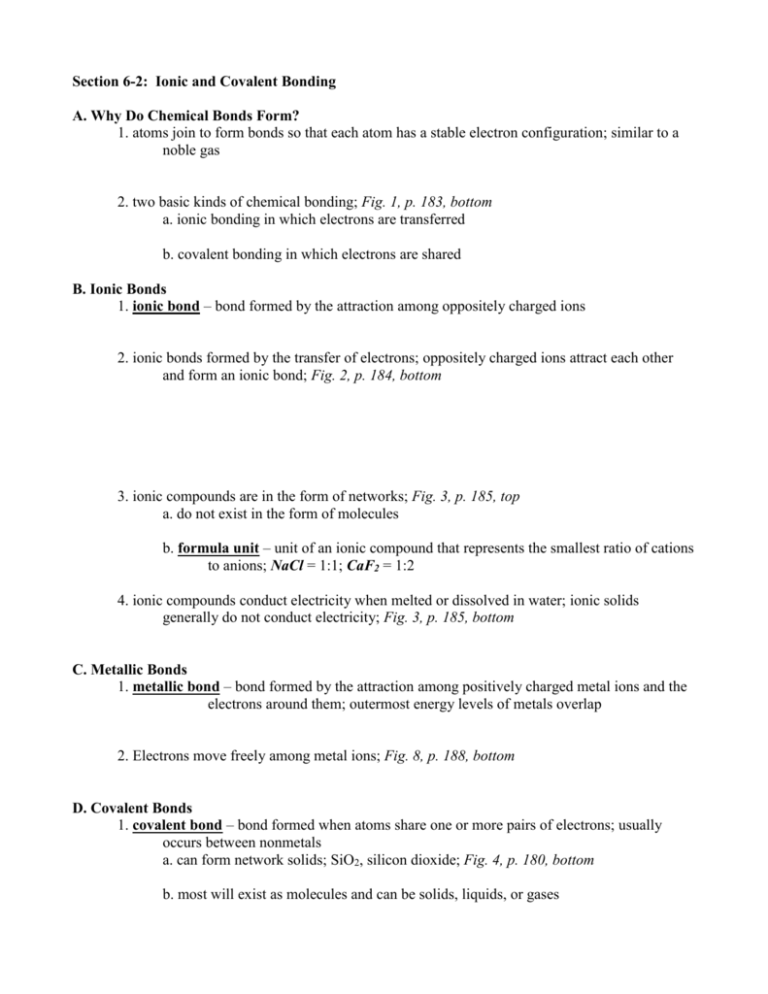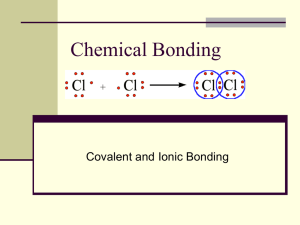Unit 1 – The Science of Life
advertisement

Section 6-2: Ionic and Covalent Bonding A. Why Do Chemical Bonds Form? 1. atoms join to form bonds so that each atom has a stable electron configuration; similar to a noble gas 2. two basic kinds of chemical bonding; Fig. 1, p. 183, bottom a. ionic bonding in which electrons are transferred b. covalent bonding in which electrons are shared B. Ionic Bonds 1. ionic bond – bond formed by the attraction among oppositely charged ions 2. ionic bonds formed by the transfer of electrons; oppositely charged ions attract each other and form an ionic bond; Fig. 2, p. 184, bottom 3. ionic compounds are in the form of networks; Fig. 3, p. 185, top a. do not exist in the form of molecules b. formula unit – unit of an ionic compound that represents the smallest ratio of cations to anions; NaCl = 1:1; CaF2 = 1:2 4. ionic compounds conduct electricity when melted or dissolved in water; ionic solids generally do not conduct electricity; Fig. 3, p. 185, bottom C. Metallic Bonds 1. metallic bond – bond formed by the attraction among positively charged metal ions and the electrons around them; outermost energy levels of metals overlap 2. Electrons move freely among metal ions; Fig. 8, p. 188, bottom D. Covalent Bonds 1. covalent bond – bond formed when atoms share one or more pairs of electrons; usually occurs between nonmetals a. can form network solids; SiO2, silicon dioxide; Fig. 4, p. 180, bottom b. most will exist as molecules and can be solids, liquids, or gases PS 6-2b 2. atoms joined by covalent bonds share electrons; Fig. 5, p. 186, bottom a. nucleus of one atom attracts electron of the other, and vice versa b. attraction pulls the two atoms closer together; electron clouds cross each other forming one cloud c. shared cloud has two electrons d. nonpolar covalent bond – bond in which the electrons are shared equally 3. atoms may share more than one pair of electrons a. double covalent bond – covalent bond in which two pairs of electrons (4 total) are shared; stronger than single bonds; Fig. 6, p. 187, top; example O2 b. triple covalent bond – covalent bond in which three pairs of electrons (6 total) are shared; stronger than double bonds; Fig. 6, p. 187, top; example N2 4. polar covalent bond – bond formed by the unequal sharing of electrons between two atoms a. electrons usually attracted to elements that are farther right and up on the periodic table b. produces partial positive and negative ends on the molecule; Fig. 7, p. 187, right E. Polyatomic Ions 1. polyatomic ion – an ion composed of two or more atoms; Fig. 97, p. 189, right a. groups of covalently bonded atoms that have either lost or gained electrons b. behavior is same as any other ion 2. many common polyatomic ions; Fig. 10, p. 190, middle 3. place polyatomic ion in parentheses in formula; (NH4)2SO4, not N2H8SO4 4. Some polyatomic anion names relate to their oxygen content; charge is same a. –ate indicates one more oxygen atom; sulfate (SO42–), nitrate (NO3–) b. –ite indicates one fewer oxygen atom; sulfite (SO42–), nitrite (NO3–)







